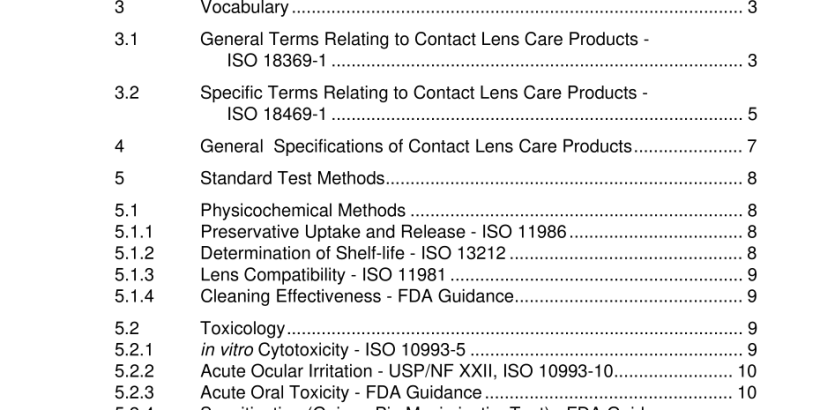ANSI Z80.18-2016 pdf download.Contact Lens Care Products – Vocabulary, Performance Specifications, and Test Methodology
1 Scope
This American National Standard applies to contact lens care products (CLCP) which are marketed for use with hard (PMMA), rigid gas permeable (RGP), enhanced oxygen permeable materials, and soft hydrophilic contact lenses. These products are intended for use in the care of contact lenses: e.g., rinsing, storing, disinfection, conditioning, neutralization, cleaning, hydration, and/or for alleviating discomfort of lens wear and improving lens tolerance by physical means. This standard provides test methodology to be used in developing performance specifications of CLCP by function and where appropriate provides acceptable performance specifications for specific products. It also addresses general requirements for CLCP based upon physical state of the marketed product (solutions, granules, and tablets), the packaging configuration (including conventional plastic container, aerosol container, form-fill-seal, or blister pack), and mode of use (unit dose or multi-dose).
2 References
The following standards contain provisions which, through reference in this text, constitute provisions of this American National Standard. At the time of publication, the editions indicated were valid. All standards are subject to revision, and parties to agreements based on this standard are encouraged to investigate the possibility of applying the most recent editions of the standards listed below. Members of IEC and ISO maintain registers of currently valid standards.
4.1 A contact lens care product marketed as a solution must be sterile until opened in accordance with 21CFR 800.10. Terminally sterilized products should meet an SAL of < 10 -6 . Products aseptically processed shall be prepared in accordance with a validated and documented process. See 5.3.2. (See ISO 13408-1 and PDA TR no. 22)
4.2 Solution products marketed in multi-dose containers shall meet the requirements of the preservative efficacy test included in this standard (See 5.3.4) or be so packaged and/or labeled as to minimize the risk of contamination during use (21CFR 800.10). Unit dose containers do not require preservative efficacy testing. See 5.3.4 in this ANSI standard.
4.3 Solid lens care products, including tablets and granules, supplied as non-sterile shall be manufactured to yield a bioburden of less than 100 cfu per gram during their shelf-life; the product shall be free of the following pathogens: Staphylococcus aureus, Pseudomonas aeruginosa, and Escherichia coli in accordance with ISO 14534. See 5.3.3 in this ANSI standard.
4.4 The containers of contact lens care solutions shall be sterile at the time of filling and closing, and the container or individual carton shall be so sealed that the contents cannot be used without destroying the seal in accordance with 21CFR 800.10 (a)(3). A solution, tablets, or other dosage forms regulated as a medical device and intended for use with contact lenses shall be packaged in a tamper-resistant package, if this product is accessible to the public while held for sale. A tamper-resistant package is one having an indicator or barrier to entry which, if breached or missing, can reasonably be expected to provide visible evidence to consumers that tampering has occurred. The indicator or barrier to entry is required to be distinctive by design or by use of an identifying characteristic. A tamper-resistant package may involve an immediate-container and closure system or secondary-container or carton system or any combination of systems intended to provide a visual indication of package integrity in accordance with 21CFR 800.12.
4.5 Eye cups, eye droppers, and other dispensers intended for ophthalmic use should be sterile and be so packaged to maintain sterility until the package is opened in accordance with 21CFR 800.10(c).
4.6 Each manufacturer of any class III or class II device shall establish and maintain procedures to control the design of the device in order to ensure that specified design requirements are met in accordance with 21CFR 820.30.ANSI Z80.18-2016 pdf download
